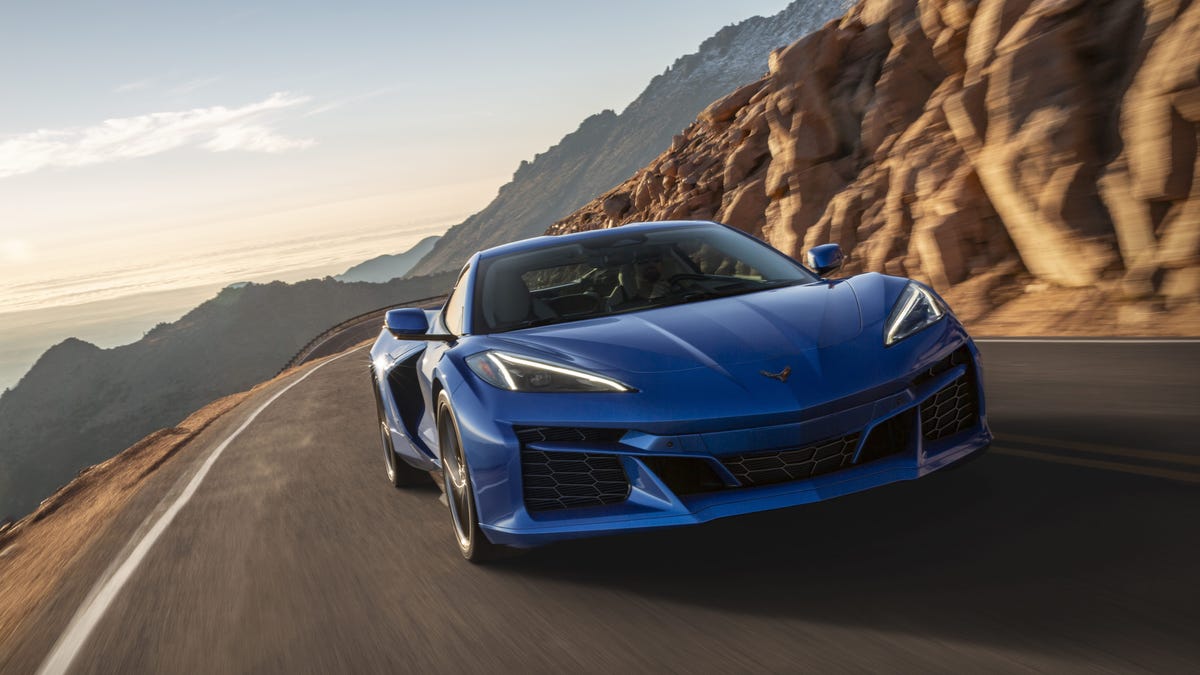I’ve never driven anything that got me as excited for the future of performance as the Corvette E-Ray. This car delivers a level of performance once reserved for multi-million dollar machines, only approachable by those in the highest of ivory towers. Just as the Corvette has always done, this electrified version brings previously unattainable speed to the (relative) masses.
This mad machine will do it all, out-accelerating anything in its tax bracket, delivering track potential well beyond the skillset of most drivers, and still delivering decent fuel economy, daily driver comfort, and all-weather all-wheel drive. I’d call it a jack-of-all-trades, but that implies it is master of none. This car went to trade school and didn’t stop learning them until it graduated from every available course with honors.
It’s time to embrace the battery as the future of go-fast. The technology has been trickling down for over a decade, and the E-Ray takes full advantage. How do you make more power without the associated noise, vibration, and harshness of a track-focused Z06? Bolt a battery in the middle and drive the front wheels with 160 horsepower of pure electrons.
Full Disclosure: Chevrolet flew me to Denver, Colorado to drive the new Corvette E-Ray on the street and on the track. I was given a nice hotel room and plenty of delicious food.
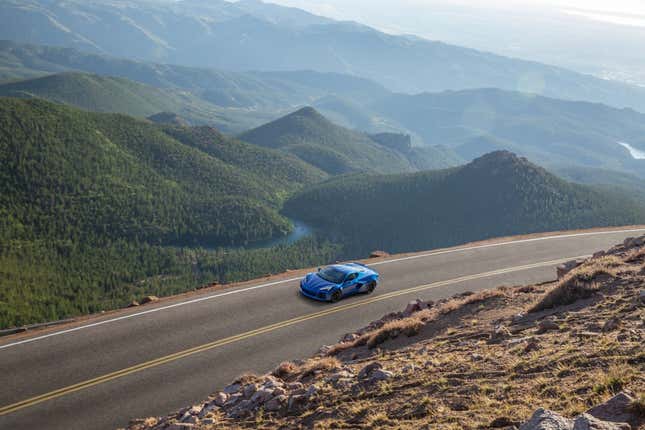
Just a decade ago, this kind of performance was reserved for the most keyed up of hyper cars. The Corvette team benchmarked Porsche’s million-plus-dollar 918 Hybrid in the development of the E-Ray, but wanted to deliver the easy operation and every-day driving comfort of the brand’s newest Carrera 4. Based on my time behind the wheel, I’d venture that they succeeded.
What Is The Chevrolet Corvette E-Ray?
Chevrolet’s eighth-generation Corvette is the undisputed king of punching above its weight class, and the E-Ray continues that legacy. Looking at a chart of statistics alone, the E-Ray delivers the kind of performance you can’t touch from any other manufacturer for less than $200,000. The Corvette E-Ray’s 2.5-second 0-60 time and 10.5-second quarter mile come with low enough fuel consumption to avoid the gas guzzler tax.
For decades the engineers behind America’s most successful sports car have been looking for a way to add all-wheel drive to the Corvette lineup. There are complex front-engine, all-wheel-drive systems like that found in the Nissan GT-R or Jaguar F-Type, but those were ruled out for C6 and C7 generations. When the C8 moved to a mid-engine platform, Chevy engineers knew they had their shot. For packaging reasons, they once again decided against a transfer case and front differential setup. Electric propulsion was deemed the best way to drive the Corvette’s front wheels.
What do you get when you take the widebody, track-focused chassis and carbon-ceramic brakes from the Corvette Z06 and fit it with the standard Stingray’s 495 horsepower engine? That sounds like a pretty fun time. Corvette engineers then decided to pump things up even further with an extra 160 horsepower of electric motor on the front axle. Compared to the Z06 it shares its body with, the E-Ray only gains 53 pounds (3,774 pounds vs 3,721 pounds). That weight gap certainly would have been much higher were the front wheels gas engine driven. Going hybrid was purely a performance decision.
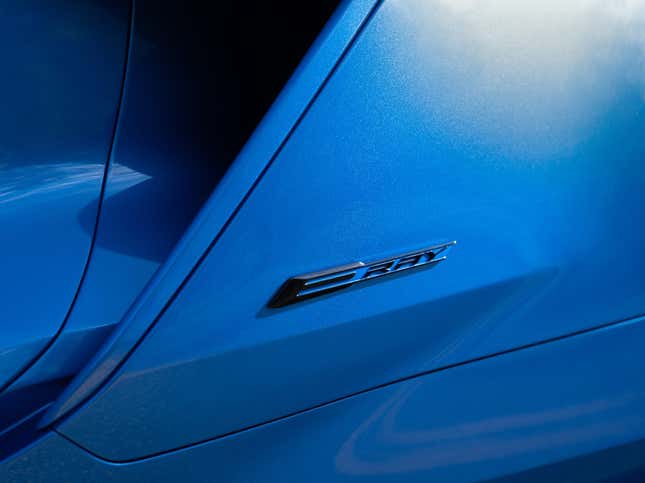
The E-Ray began development nearly a decade ago, and the hybrid provisions were baked into the C8 from the very beginning. The polarizing driver-focused center console, for example, was built to accommodate the 1.9 kWh battery underneath. Way back then, the Corvette team walked down the hall to visit the Volt/Bolt teams and discuss hybrid integration and battery development. The greenies looked at the V8 tire smokers and asked some dumb questions about fuel economy goals and electric-only range. The Corvette engineers basically told them their priorities were out of whack, and they needed the electric system for speed and all-weather driving.
How Does The Corvette E-Ray Drive?
Last month I flew to beautiful Denver, Colorado to experience the E-Ray firsthand. On day one I was afforded the opportunity to drive some of the best twisty mountain roads Colorado has to offer. On day two I headed down to Pikes Peak International Raceway for some time on an autocross course and a handful of laps on the modified roval course. The weather was impeccable both days.
Getting in the car everything looks pretty standard Corvette fare. If you press the start button, however, you’re treated to a new hybrid-specific screen and a few new options. On startup there are two all-electric operating modes, Shuttle and Stealth. Shuttle is just for moving the car around in your driveway or garage without kicking on the motor. Stealth, however, allows all-electric operation of the E-Ray on the street for a handful of miles, so long as you keep speeds below 45 miles per hour, and you don’t press the accelerator too hard. It seems like the kind of thing you’d use on your way out of your neighborhood at 5AM on your way to an autocross day or something.
Once the motor fires up, though, there’s no way to shut it off again without killing the whole car. There’s no selectable EV mode, no matter how full your battery is.
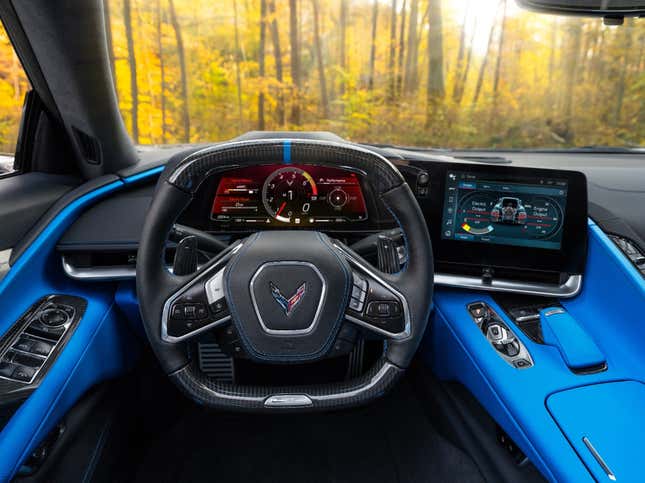
In most regular dry street driving situations, you largely forget that the Corvette E-Ray is a hybrid or all-wheel drive at all. There were very few situations that demanded more battery than the brakes could regen before the next corner. For the most part it’s a quiet and comfortable driving experience. The magnetic ride suspension keeps road imperfections from reaching your backside. The 495-horsepower LT1 V8 delivers power like a knife spreads room temperature butter.
When you jump on the accelerator, however, you’re reminded that this isn’t any ordinary Corvette. The launch control pulls as hard as any super EV I’ve experienced, and with a 2.5-second 0-60 it’s enough to set your head back in the seat. Every dig out of a tight corner engages the electric motors to pull as hard as possible to eke out every bit of shove. We already know the C8 Corvette is a competent car through the corners and on acceleration, but this pumps things up to another level.
160 more horses and two additional traction wheels really amp up the blast. You really drive this car like an all-wheel drive car, pointing the nose where you want it to go and squeezing on the throttle. It’s more of a point-and-squirt car than any mid-engine car I’ve ever driven. When you get the zoomies, this is an entirely different driving experience from any other Corvette that has ever been built.
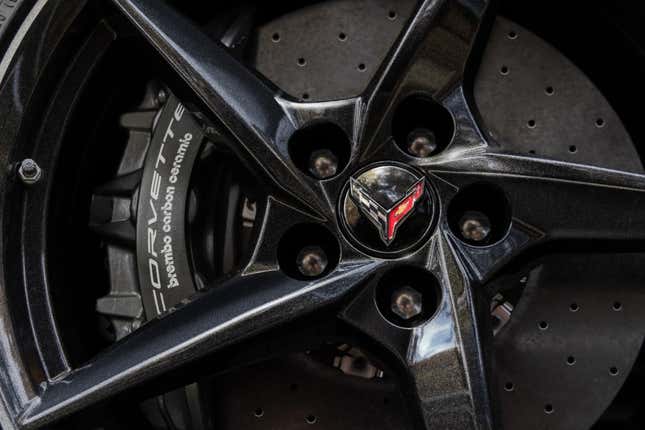
There is one minor downside to adding electricity to a Corvette, and that’s the braking feel. When you’re really pushing into the twisty stuff, you might find a few times that the transition from regenerative braking to kinetic braking with the carbon ceramics is a bit wonky. I don’t know if this is caused by the carbon rotors cooling off too much as they aren’t needed as much, or if you’ll eventually learn a better way to drive around the condition with seat time. There’s a moment about halfway down the brake pedal where you suddenly feel like you need to push a lot harder, because you aren’t stopping as quickly as you think you should be. A couple of times on the street this pushed me near the brink of subconscious panic, but never went over the edge.
Getting On Track With The Corvette E-Ray
I will preface this by saying PPIR is not the right track for the E-Ray, and particularly not the layout that Chevrolet allowed us to use. I only got six laps to learn how it worked, but I’ll take six laps at a non-optimal track over no laps anywhere. It’s a small track without much high-speed driving, and the infield is switchbacky, bringing out the weight of the car.
We did lead-follow for a few laps with an instructor, and they didn’t let me go as fast as I knew I was capable of. On the back straight, I was at half-throttle for much of that, seeing a top speed of only about 110 miles per hour. I’m sure I’m far less capable of a driver than this car can accommodate, but I reckon I could have been around 150, and still had way more than enough braking zone to drop down off the banking into the infield. We were originally supposed to continue on out of the infield onto the front straight, but before we could helmet up and get out there, the engineers decided that we should instead pull into pit lane every lap to cool off. So we never really got a complete flying lap of the course. That was annoying, but it’s not my car, so I don’t get to make the rules.
Even still, this exercise was a good time, because I got lots of experience braking way early, gently rolling through the corner, and then dragging up out from the apex with the steering pointed at track out and the throttle buried in the carpet.
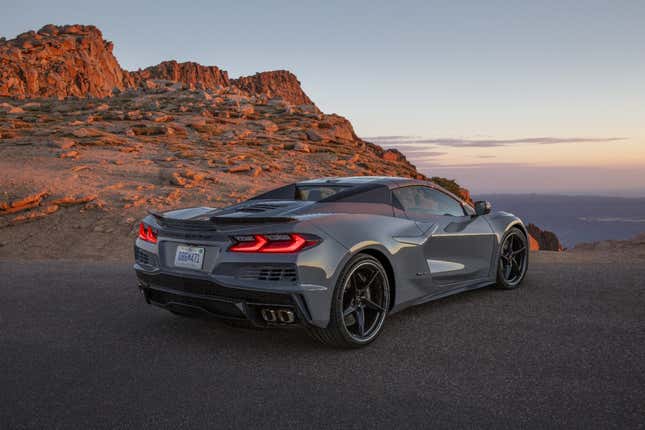
It’s obvious that this is a fast GT car on a race track. It has ludicrous speed off the corner, and it feels like it can go on to incredible speeds (when the reins are removed.) It’s a big car, but it’s still a Corvette and carries that weight well. The magnetic ride works well in its performance modes, firming up where it needs to and softening to absorb bumps and kerbs. Good stuff.
There are a few interesting modes to play with on track as well. The electric engineers behind the battery deployment are earning their paychecks. There is a button at your right hip that allows a mode called “Charge+” which pulls back the electric energy after the initial off-corner pull in order to retain battery strategy for consistent lapping. Your outright lap time won’t be quite as quick, but you’ll be able to pull a faster average lap than without it on. If you’re setting a flying lap for qualifying, you can turn Charge+ off to allow max electric boost at all times. You’ll run out of juice faster, and your average lap time will fall, but you’ll have set that one hero lap. It’s a fun little trick to play with, and instantly noticeable behind the wheel.
As standard, the E-Ray wasn’t built for the race track, but you can option it with carbon fiber wheels and sticky summer-only Michelins. The Corvette team isn’t going to tell you that you can’t take your sports car to a track. And depending on the track, this could be quick enough to give a Z06 a run for its money. When low-speed acceleration is the name of the game, the E-Ray will win out. Four-wheel traction and electric torque are hard to beat in a game of fast laps. At a faster and more flowing track, however, the Z’s downforce and power advantage will give it the upper hand.
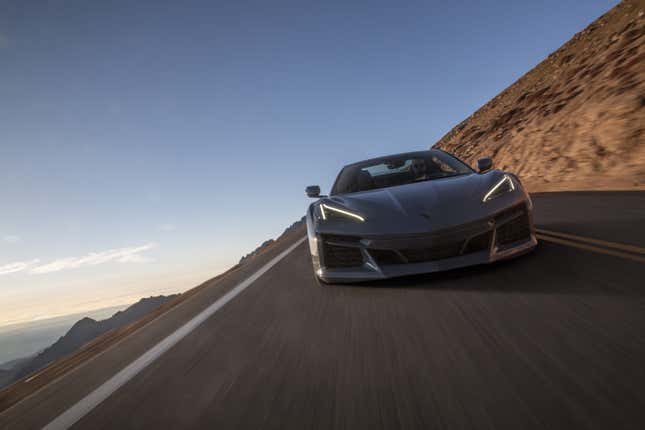
Corvette Is The American Porsche 911
It’s hard to look at the current Corvette lineup and not draw direct comparisons to Porsche. It’s fitting because Corvette has been compared to 911 since the 1960s, though never has America’s sports car seen as favorable a comparison as it warrants today. The incredible high-strung naturally-aspirated Z06 is to Corvette as GT3 RS is to Porsche. The Stingray compares directly to the standard 911, natch. So it stands to reason that the street-oriented, comfort-focused, all-wheel-drive model with a bunch of tech onboard—Corvette E-Ray—is the direct analogue to Porsche’s range-topping 911 Turbo S. Porsche considers its three pinnacles to be street, track, and off-road—conquered by 911 Turbo S, GT3 RS, and Dakar respectively—so we only need Chevy to deliver an off-road Corvette to complete the set.
Many will probably eschew comparisons to the 911 Turbo S in favor of the recently shelved Acura NSX, for obvious reasons. Both the E-Ray and the NSX are mid-engine two-seaters with electric all-wheel drive and big horsepower, and both were engineered by their respective manufacturers to deliver daily driver comfort. The NSX has been met with confusion and occasionally derision since its launch in 2017, though Acura seems to have pulled a card from the GM deck and delivered the perfected Type S version right before killing off the model.
So what did Corvette E-Ray get right that NSX got wrong? For one thing, it’s got an extra fifty-five ponies and a good 100 fewer pounds. For another, it’s seventy grand cheaper. For a third, the E-Ray gets your blood pumping with several cubic inches of raw American V8, brother! There’s nothing subtle about the E-Ray. It is the high school quarterback to the NSX’s egghead science club captain. The NSX always feels in complete control, using its three electric motors and advanced driver aids to mete out exactly what it needs where it needs it, but the E-Ray can be a rowdy bucking bronco in the best way possible.
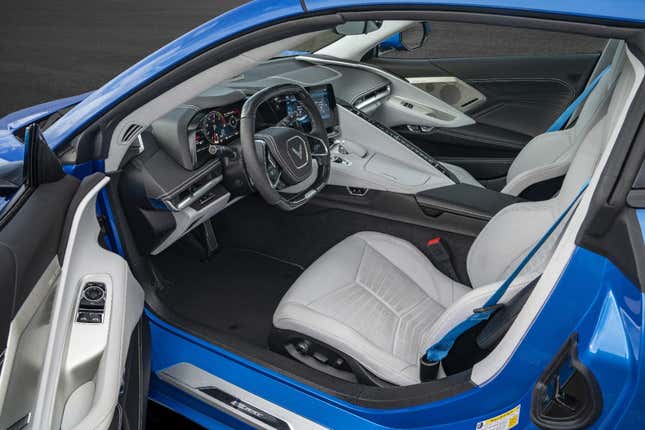
This is maybe the most ambitious Corvette in history, and aside from a few minor quibbles it really delivers on that. Considering the price point and the competition, it’s maybe the best bang-for-the-buck hypercar on the market, and maybe the most exciting sports car ever built on American soil.
What I Liked
The standard Michelin Pilot Sport All Season 4 tires are impressively grippy for an all-season run-flat tire. I still preferred the car with the summer tires, but for most driving these work just fine. You’re not going to outdrive these on the street. Well, you shouldn’t, anyway.
There are a couple of really bold color packages that you can get with the E-Ray. If you’re really leaning into the GT vibe of the car, I’d recommend trying out the Cacti green exterior paint with the Artemis green Napa leather interior (see below).
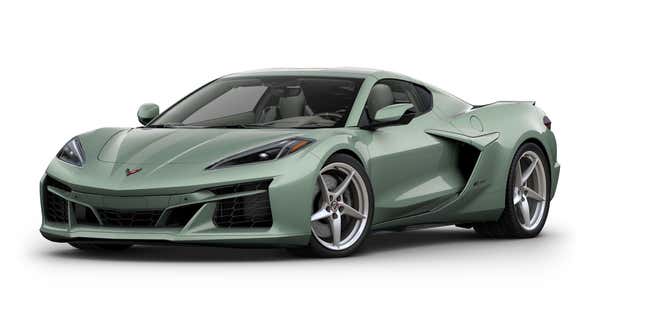
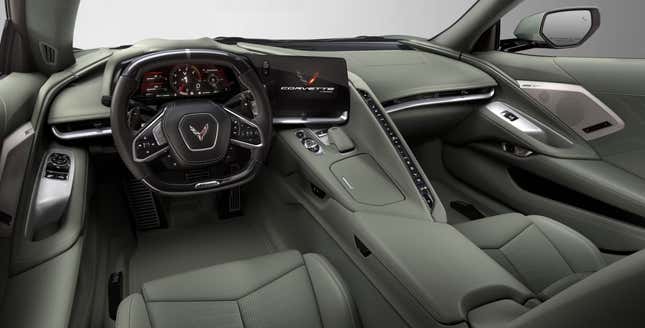
The user interface for this car was easy to work with and simple to read. You can pare back the gauge cluster to be just a speedometer and tach, blacking everything else out, and that’s my favorite way to drive when I want to focus on the road ahead.
The optional 12-speaker Bose system is exceptional, aided by the small cabin and decently damped road noise.
What I Didn’t Like
As a long-in-the-torso 6’2″ American-sized man, I found the E-Ray to be slightly too short of a cabin for my liking. I managed to find a way to get comfortable enough to drive the car for about 90 minutes and ride in the passenger seat for another 90. Fitting with a helmet for the on-track portion of the test was more difficult, though still not impossible. Finding a way to mount the seat an inch or two lower would solve most of my problems with this car.
The square steering wheel isn’t great, but it is infinitely better than a yoke.
The E-Ray-specific body-colored grille inserts (front and rear) and side cove trim aren’t my style. The C8 is already a polarizing piece of design, and these further extend the car’s awkward looks. These are all black on the Z06, and it looks so much better. There is a “carbon flash exterior accent package” available, which I consider to be mandatory.
The fact that there’s no EV mode button. I want to be able to drive a 160-horsepower front-wheel drive electric Corvette whenever I have a battery full. I don’t expect to be able to do my daily driving on electric power, but it’s nice to be able to creep through a neighborhood, or past a speed trap cop, without a roaring V8 behind me.
The optional polished finish wheels (below) are heinous.

All The Comfort And Speed $106,595 Can Buy
When you look at what you can buy today for $107,000 there’s honestly nothing I’d recommend over the Corvette E-Ray. In Porsche land, you can’t even get a base 911 for that much anymore. The Cayman or Boxster GTS 4.0 might come close, but I think I’d still rather have the hybrid ‘Vette. Of course, all of this is predicated on the fact that you can actually get an E-Ray for $107,000. The options lists stack up fast, and it seems there is likely to be some serious dealer markup. Shop strategically, or wait until initial demand has been sated, and you’ll have a good car at a decent price.
You’re not going to get extreme luxury with a Corvette, because, well, it’s a Corvette and not a Bentley or whatever. The C8 is a massive step up in quality from previous Corvette generations, and that pays dividends in the E-Ray. There is a substantive feel to the car, probably owed to its near-4,000 pound weight. There isn’t the plasticky feel of previous Corvettes, and the touch points have the necessary feel. Some of the buttons are parts bin specials, but I think GM has really upped the quality across the board, so that’s not as big an insult as it might have been in 2003.
This is a car that is built around pure acceleration, but unlike a Tesla Plaid or Rivian, this is a pony with more than one trick. Yes, it’ll scoot and shoot, but it can also hold its own on a track, a twisty road, or an autocross course. The speed is probably too much for most people to handle on most roads, but unlike a track-focused car like the GT3 RS or Z06, it can settle down and act like a normal car when you aren’t in a giddy-up mindset.
The real trick of this car is how sedate it feels cruising at 70 on the highway. Four of the cylinders shut down, and the hybrid system does its all to improve NVH and fuel economy when throttle inputs ease. I saw real-world MPGs in the high 20s, which is truly impressive for a 650-horsepower car. I’d like to take one on a road trip of the country, partly because it wouldn’t even bankrupt me on the fuel costs. Unlike the Escalade V or Ram TRX, the Corvette E-Ray feels like a performance car that has a conscience. It isn’t going to save the world, but it isn’t leaning into destroying the world (or your neighborhood noise levels) either.
I can only hope that Chevrolet will keep trickling down this kind of electrified performance to its lesser models. Maybe the 7th-generation Camaro will incorporate a hybrid powertrain instead of the doom-and-gloomer predictions that it’ll evolve into an electric sedan. The E-Ray proves that Chevrolet knows how to integrate electric drive systems into its best sports car ever, and make it greater than the sum of its parts. Let’s hope they don’t cancel the damn thing right when they’ve made the best Corvette in history. Don’t 1988 Fiero GT this, GM!
It took seventy years for Corvette to get here. And it was worth the wait.

